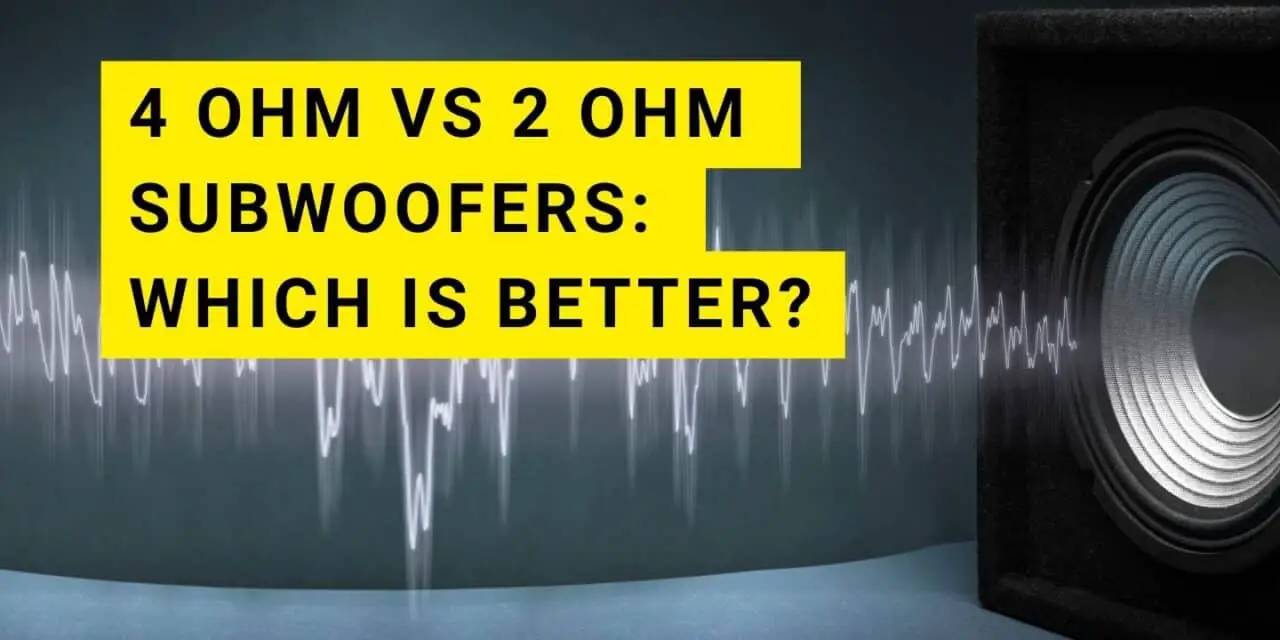Have you ever found yourself trying to wrap your head around all the confusing audio terms dealing with subwoofers?
Ohms. Impedance rating. Electrical Resistance.
C’mon, we’re musicians, not electrical engineers (although “sound engineer” has a nice ring to it).
So, what’s the real deal with subwoofers, and why does this thing called ‘impedance’ matter so much?
Subwoofers are that secret sauce, the invisible ingredient that can elevate your favorite jam from a simple tune to an immersive, room-shaking, soul-stirring experience.
And in the heart of these mighty sound beasts lies a number – an ohm value – that holds the key to how your subwoofer performs.
The battle between the 4-Ohm and 2-Ohm subwoofers is all about impedance, and it’s a factor that can make or break your sound system.
So, let’s begin our journey into the world of ohms, watts, and decibels!
Importance of the Subwoofer: What’s All the Hype About?
Let’s kick things off by understanding what a subwoofer really is. Picture this: you’re in a concert, your favorite band’s on stage.
The guitars are wailing, the drums are banging, and amidst all this, you feel a pulsating thump, a rhythmic vibration that you can practically feel in your bones.
That, my friends, is the magic of the subwoofer.
In essence, a subwoofer is a speaker, but not just any speaker. It’s a specialized breed designed to produce the lowest range of frequencies in your sound system – we’re talking those ultra-low bass sounds that make you want to get up and groove.
Ever felt your heart match the beat of a pumping bass line or the rumble during an epic movie scene? Yup, that’s the subwoofer doing its thing!
The importance of a subwoofer in any sound system can’t be overstated. Sure, regular speakers can handle a decent range of frequencies, but when it comes to the bottom end – the deep, resonant lows – you need a subwoofer to do justice.
By reproducing these low frequencies, a subwoofer adds depth and fullness to the sound, providing a more complete and immersive audio experience.
Whether it’s the hard-hitting punch of a bass drum in a rock song, the dramatic rumble of thunder in a horror movie, or the layered, textured low-end in an orchestral piece, a subwoofer ensures that nothing gets lost in translation. It fills in the gaps, the spaces that other speakers leave behind, and brings your music and movies to life.
So that’s the scoop on subwoofers. But remember when we mentioned ‘impedance’ earlier? Yeah, we’re circling back to that now. Strap in, folks, ’cause we’re about to dive deep into the heart of your subwoofer, where the real action happens.
Decoding Ohms: The Role of Impedance in Subwoofers
Alright, time to navigate the often misunderstood, occasionally intimidating, but always crucial world of impedance. But fear not! We’re not in a physics lecture, so we’ll keep things light, engaging, and—most importantly—simple.
Impedance, measured in ohms, is essentially the measure of how much a device—like our good ol’ subwoofer—resists or obstructs the flow of electrical current. Think of it like a bouncer at a trendy nightclub—the lower the impedance (or ohms), the more electrical current (or party-goers) it allows to flow through.
But why should you care about impedance in a subwoofer? Well, impedance affects two key things—power and compatibility. A subwoofer’s impedance dictates how much power it can draw from an amplifier. Lower impedance (like 2 ohms) can draw more power, potentially leading to a louder sound. However, it also means a greater load on your amplifier, so you need to ensure it can handle the heat!
The 4-Ohm Subwoofer: The Standard Bearer
Now that we’ve navigated the waters of impedance, let’s meet our first contender in the ohm showdown—the 4-Ohm subwoofer. This is your standard, everyday subwoofer, often found lounging in home audio systems and car stereos around the world.
Why is it so popular, you ask? Well, the 4-Ohm subwoofer strikes a balance—it draws enough power to provide a robust, clearer sound without putting too much strain on most common amplifiers. It’s kind of like the Goldilocks of subwoofers—not too demanding, not too mild, but just right for most listeners out there.
But of course, it’s not all sunshine and roses. While 4-Ohm subwoofers are less likely to tax your amplifier, they might not pack as much punch as their lower impedance counterparts. For those hungry for more power—think booming car audio systems or home theaters—a 4-Ohm subwoofer might leave you craving more.
Don’t get us wrong, though. The 4-Ohm subwoofer is a solid choice for most general uses and in higher-quality audio settings.
It’s reliable, efficient, and well-suited to handle a range of music styles. Just don’t expect it to rock your world if you’re a bass junkie or a power-hungry audio enthusiast.
Overall, the 4-Ohm subwoofer has a higher resistance rating and produces more compact sound quality – which will be desired in most situations.
The 2-Ohm Subwoofer: Louder Sound & More Power
Now, let’s meet our second challenger in the ohm face-off—the 2-Ohm subwoofer.
Picture the 4-Ohm subwoofer’s beefier, bolder cousin. This is the daredevil of the subwoofer world, taking power handling to new heights.
Unlike the 4-Ohm subwoofer, the 2-Ohm variant is all about packing a punch. Remember our nightclub analogy? Well, a 2-Ohm subwoofer is like a bouncer who’s feeling extra generous, letting more ‘party-goers’ (current) through the door (meaning lower resistance).
The result? More power, louder volumes, and a sound that can really make your chest thump.
But as with everything in life, this extra power comes with a catch. More power means more strain on your amplifier. Picture a marathon runner pushing to maintain a sprinter’s pace—it’s possible, but it can be tough on the system. So, if you’re going with a 2-Ohm subwoofer, make sure your amplifier can handle the extra load.
That being said, if you’ve got an amplifier that’s up to the task and you crave that bone-rattling, heart-pounding bass, a 2-Ohm subwoofer can be your ticket to audio nirvana. Ideal for bass-heads, car audio enthusiasts, and anyone looking to push their sound system to the limits, this bad boy knows how to deliver.
While 2-Ohm subwoofers might seem like the ideal choice, the larger power consumption often times comes with poorer sound quality. The lower electrical resistance rating can make for a cheaper speaker that has bad sound quality so if the price tag seems too good to be true – it probably is.
Do Ohms Affect Sound Quality?
Simply, put – yes. A higher impedance speaker will likely produce a greater audio signal and have better sound quality.
What is the difference between a Single Voice Coil and a Double Voice Coil Subwoofer?
The terms “single voice coil” and “double voice coil” (or dual voice coil, DVC) are often brought up in the subwoofer conversation. They refer to the number of voice coils in a subwoofer, and they can indeed impact your decision when choosing between a 4-Ohm and a 2-Ohm subwoofer.
Single Voice Coil (SVC)
In a single voice coil subwoofer, there’s only one voice coil and one circuit. This limits the flexibility of wiring your subwoofer to your amplifier. A single voice coil subwoofer usually comes in common impedance ratings like 2-Ohm, 4-Ohm, or 8-Ohm.
Dual Voice Coil (DVC)
A dual voice coil subwoofer has two separate voice coils, each with its own connections, mounted on one cylinder and connected to a common cone. The advantage of dual voice coils in a subwoofer is the flexibility offered. You can wire the subwoofer in multiple ways to extract different impedance values.
For example, a DVC subwoofer rated at 2-Ohm per coil can be wired to output a 4-Ohm impedance or a 1-Ohm impedance depending on how you are wiring multiple subwoofers.
Connection to 4-Ohm vs. 2-Ohm Debate
The connection between SVC, DVC, and the 4-Ohm vs. 2-Ohm subwoofer debate lies in the wiring and the resulting impedance. If you have a DVC 4-Ohm subwoofer, you can wire it to present a 2-Ohm impedance to the amplifier (when wired in parallel), maximizing power output. Conversely, the same subwoofer could also be wired to present an 8-Ohm load (when wired in series), reducing the overall power output but perhaps better matching your amp’s capabilities.
Similarly, a DVC 2-Ohm subwoofer can be wired to present a 1-Ohm load (parallel) for maximum output power, or a 4-Ohm load (series) for reduced power.
In a nutshell, whether you choose a 4-Ohm or 2-Ohm subwoofer can be influenced by whether the subwoofer is SVC or DVC. A DVC subwoofer gives you more flexibility in matching the subwoofer’s impedance to the capabilities of your amplifier. Remember, the goal is to match the subwoofer’s impedance to the amplifier’s optimal load to maximize excellent sound quality and prevent damage to your audio equipment.
The Great Debate: 4-Ohm vs 2-Ohm Subwoofer
Now that we’ve met our contenders, it’s time for the main event—the 4-Ohm vs 2-Ohm showdown. Both have their strengths, and both bring something unique to the table. The choice between the two often boils down to your individual needs, preferences, and existing equipment.
The 4-Ohm subwoofer, with its balanced power handling and wide compatibility, is the ‘people’s champ.’ It’s your trusty companion that won’t give you any unpleasant surprises and will deliver a satisfying, well-rounded performance every time. It’s the go-to choice for most casual listeners, music lovers, and home theater enthusiasts. If you are dealing with a professional audio system, you will likely have 4-ohm subs.
On the other hand, the 2-Ohm subwoofer is the ‘thrill-seeker’s choice.’ It’s all about pushing boundaries and delivering high-volume, powerful bass that can make your heart skip a beat. But with great power comes great responsibility, and in this case, that responsibility falls on your amplifier.
Both these subwoofers can bring your music and movies to life, but in their own unique ways. But which one should you choose?
The Verdict: Choosing Your Subwoofer
So, you’ve made it to the finish line, and it’s time to pick a winner in this 4-Ohm vs 2-Ohm showdown. But here’s the twist: the real winner is going to be your sound system, regardless of which subwoofer you choose. The trick lies in understanding what you want from your sound experience and aligning that with the subwoofer that can deliver it best.
If you’re someone who wants a reliable, all-around performer that’s easy on your amplifier, then the 4-Ohm subwoofer is your champ. It’s the subwoofer that says, “Hey, let’s keep things chill, deliver good sound, and have a good time without pushing things too far.” It’s ideal for general home audio systems, casual music listening, or a standard home theater setup.
On the flip side, if you’re an adrenaline junkie for louder sound, if you can’t resist the lure of the deepest, loudest bass, and if your amplifier has the muscles to handle it, then step right up and embrace the 2-Ohm subwoofer. This is the sound beast that says, “Hold on tight, ’cause we’re about to take your audio experience to the max!” It’s perfect for car audio systems, dedicated home theaters, and anyone who wants their bass to be felt as much as heard.
Conclusion on the Better Subwoofer
There’s no universal winner—just what works best for you and your sound setup. Whether you’re Team 4-Ohm or Team 2-Ohm, remember, it’s all about finding the right balance of power, compatibility, and, above all, sound quality that makes your audio experience sing. To recap:
2-Ohm Subwoofer: Louder Audio, Lower Quality, Pushing the Limits to the Thump
4-Ohm Subwoofer: Better Sound Quality, Overall the Standard Choice for Normal Applications
Keep in mind your personal sound preferences, the capacity of your amplifier, and the context in which you’ll be using your subwoofer. That way, you’ll come out with a subwoofer that’s not just an addition to your sound system, but a real game-changer.
With that, we’re signing off. Happy listening, and remember—the best sound is the one that makes you feel good!






